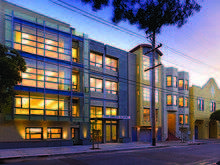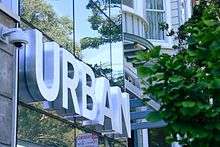The Urban School of San Francisco
Urban School of San Francisco is an independent coeducational high school located in the Haight-Ashbury district in San Francisco, California. [1]
| The Urban School of San Francisco | |
|---|---|
 | |
| Location | |
| |
| Information | |
| Type | Independent |
| Established | 1966 |
| Head of school | Dan B. Miller |
| Faculty | 76 |
| Grades | 9 – 12 |
| Number of students | ~420 |
| Campuses | Oak Street Campus, Page Street Campus |
| Color(s) | Blue, Silver and White |
| Athletics conference | Bay Counties League West |
| Mascot | Blues |
| Nickname | Urban |
| Newspaper | The Urban Legend |
| Periodical | The Yeti |
| Website | urbanschool |


History
Urban was founded in 1966 by a group of Marin Country Day School parents in an effort to create a more student-centered curriculum and values [2]. Urban was the first coeducational SF private high school, the only SF high school at the time to not include letter grades, and developed a blocks schedule system focused on academic immersion and understanding. Today Urban has grown from just 22 students into a student body of over 400[3], with over 700 applicants annually for the Freshman class. [4][5]
Leadership
After 32 years, Mark Salkind retired as Head of School in June 2019. Dan B. Miller was appointed Head of School in July 2019.[6]
Evaluation and grading
Urban's grading and evaluation system discourages competition and comparison. The school, up until 2011, did not show students letter grades until their senior year. Now it provides letter grades at the end of each course, with a primary focus on written teacher evaluations. Urban teachers write two thorough reports each term for each student, providing comprehensive feedback on student achievement and setting specific goals and strategies for improvement. Students are also asked to reflect on and formally evaluate their work. [7]
Schedule and curriculum
Terms and block schedule
Urban organizes the school year using a three-term system rather than a conventional semester system. The schedule divides the academic year into three, 12-week terms: fall, winter and spring. Students take four classes every term. These classes meet for 70-minute periods with one 2-hour+ period per week.
Urban's schedule allows for more concentrated, less fragmented learning than does a traditional high school schedule. It enables students and teachers to focus on each area of study in greater depth and approach the material in a variety of ways: in-depth discussions, independent and group projects, films, research and field trips into surrounding communities and environments.
In addition, students take electives such as Jazz Band, Urban Singers, or Newspaper, or participate in a physical activity or study halls during a shorter period. There is also time for advising, grade-level meetings, all-school meetings, and consultation periods for students to meet individually with teachers within this block schedule.[8]
Curriculum
Urban’s curriculum includes core academic classes common to most high schools, as well as a number of specialized courses, advanced electives and creative arts courses usually found at the college level.
Two terms of a class make up one credit; an elective class that only lasts one term is therefore .5 credits. In order to graduate from Urban and complete the required courses for admittance to the UC system and other highly selective colleges, the following credits must be taken in each subject matter:
- 4 credits in English – Two 9th grade required classes, two 10th grade required classes, an 11th grade Shakespeare class plus another three elective English classes in 11th and 12th grades.
- 3 credits in Math – Math 1, Math 2 and Math 3 and/or advanced electives; Placement in first year math is based on a test given to incoming first years.
- 2 credits in Science – Fundamentals of Science 1A and 1B in 9th grade, Fundamentals of Science 2A and 2B in 10th grade with strong recommendation for additional electives.
- 2 credits in History – One credit in 9th grade (20th Century World History 9A and 9B), and one credit in 10th or 11th grade in US history (UAS Making America and UAS Remaking America).
- 3 credits in Language (French, Spanish, Chinese) – Placement in the levels of the language are based on a test given to incoming freshmen.
- 2 credits in Art – One-half credit in Visual or Performing Arts must be earned each year.
- 4 credits in Additional Advanced Course Work – these can be met by a fourth year of language, third year of history, third year of science, third year of art, or fourth year of math.
- 2 credits in Service Learning – 9th graders participate in Identity & Ethnic Studies, 10th graders in Community Partnerships; 11th and 12th graders earn credit through individual projects.[9]
- Many of Urban’s courses have distinctive features that set them apart as particularly challenging and comparable to college level work. These classes are designated as Urban Advanced Studies (UAS) and are recognized as honors coursework by colleges and universities. Urban does not offer AP classes, but students may take an AP test if desired.
Student life
Through strong relationships with their teachers, advisors and with each other, Urban students have the opportunity to learn early on how to navigate a culture of collaboration, inclusion and mutual respect. Urban has over 40 student clubs, as well as student government, an active outdoor and class trips program, and a student newspaper, yearbook, and online literary and arts journal. Performing arts opportunities include fall and winter theater productions, circus class performances and the annual One Acts Festival, as well as comprehensive jazz band, choral, and ensemble programs. [10]
History of equity and inclusion
Since its inception, Urban has prioritized diversity, equity and inclusion initiatives as integral to learning both in and outside the classroom. From creating one of the first admissions diversity goals in San Francisco schools in the 90's, to an annual Month Of Understanding in January, and Identity and an Ethnic Studies class for Freshmen, Urban has asserted itself at the forefront of this conversation within independent high schools.[11]
Urban is currently working toward ensuring equitable access to its programs and practices, developing inclusive teaching practices and student culture, and freedom of personal expression and experience among students. In December 2017, Urban leadership launched the initiative, Urban Thrives, which integrates diversity, equity and inclusion core values into longterm, measurable goals for the school, students, faculty, staff, and leadership. [12]
Athletics
A member of the Bay Area Conference and Bay Counties League-West (BCL-West), Urban hosts title-winning interscholastic teams in baseball, basketball, cross-country, fencing, golf, lacrosse, soccer, softball, tennis and volleyball. Athletic practices and games are held in the Mark Salkind Center Gym, the St. Agnes Gym, and other venues throughout the city and in Golden Gate Park. Over 65 percent of all Urban students participate on 27 boys, girls and co-ed athletic teams in the department. [13]
College matriculation
Graduates of the Urban School matriculate to a variety of schools, including Ivy League and highly selective public and private colleges and universities, as well as specialized schools for those gifted in science, engineering, and visual and performing arts. In the past five years, students have gone on to more than 130 colleges/universities. Typically 99-100 percent of Urban students attend a four-year college or university after graduation.[14]
Tuition
The Urban School, because it is private and self-supporting, charges $46,676 per student for tuition and laptop fees[15]. Urban provides financial aid to 30+% of its students who have demonstrated need as determined by the school and the NAIS Student Service for Financial Aid .
Student newspaper
Urban's student newspaper, called "The Urban Legend," is an award-winning member of the National Scholastic Press Association.
Campus Expansion
In September 2016, Urban opened the Mark Salkind Athletics and Academics Center, expanding the Urban campus by 50%. The new space includes a multifunctional gym, classrooms, conference rooms, office spaces, a cafeteria, and a rooftop courtyard/grass area. [16]
Virtual Urban
In response to the Coronavirus global pandemic, and California's shelter-in-place order, Urban launched their Virtual Urban curriculum March 16, 2020, with all classes remaining online[17]. Student schedules, homework policies, and more were all reassessed to accommodate both students and faculty during virtual learning.
Notable alumni
- Rebecca Walker, writer-activist, daughter of Alice Walker
- Bobby Chin, chef, restaurateur
- Gabby La La, musician
- Lhasa de Sela, musician
- Jené Morris, WNBA Guard[18]
- Alison Elliott, actress
- David Sandner, author and editor
- Phoebe Gloeckner[19]
- Zelda Williams, actress, daughter of Robin Williams[20]
- Hannah Dreier, reporter for ProPublica and former correspondent for Associated Press
See also
- San Francisco high schools
References
- http://www.urbanschool.org/
- https://vimeo.com/190486418
- https://www.urbanschool.org/about/welcome-from-the-head-of-school
- https://www.urbanschool.org/uploaded/Admissions/urban-school_profile-2018_FINAL_lr.pdf
- "School Profile 2018-2019" (PDF).
- "Welcome from the Head of School".
- "The Urban School Curriculum Guide" (PDF). www.urbanschool.org. Retrieved 2017-04-12.
- https://www.urbanschool.org/uploaded/Admissions/UrbanCurriculumGuide_2017-18_fin.pdf
- "The Urban School: Academics". www.urbanschool.org. Retrieved 2017-04-12.
- "The Urban School". www.urbanschool.org. Retrieved 2017-04-12.
- "The Urban School: Diversity & Inclusion". www.urbanschool.org. Retrieved 2017-04-12.
- "Urban Thrives 2023".
- "The Urban School: Athletics". urbanschool.org. Retrieved 2017-04-24.
- "College Matriculation 2014-2018" (PDF).
- "Affording Urban - Urban School of San Francisco". www.urbanschool.org. Retrieved 2018-08-22.
- "Student-Friendly Spaces at Urban School – PFAU LONG ARCHITECTURE". www.pfaulong.com. Retrieved 2018-08-22.
- "Virtual Urban | Covid-19".
- http://www.wnba.com/lynx/news/draft_central_2010_jene_morris.html
- http://www.urbanlegendnews.org/arts/2015/11/04/urban-school-alumna-phoebe-gloeckner-writes-the-diary-of-a-teenage-girl-resonates-with-students-40-years-later/
- http://www.urbanschool.org/uploaded/parent_portal_docs/jan09_urbanlegend.pdf